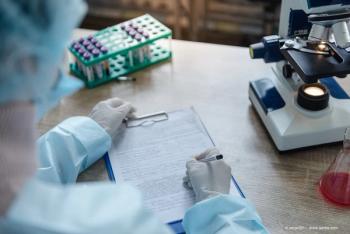
Photobiomodulation: Promising future for treating drusenoid pigment epithelial detachments in dry AMD
Investigators found that Photobiomodulation may be a valid therapeutic option to treat large soft drusen and drusenoid pigment epithelial detachments in dry AMD and may slow the natural disease course.
Photobiomodulation is an emerging treatment for dry age-related macular degeneration (AMD). Investigators who tested it in a pilot study reported that it seems to be a valid therapeutic option to treat large soft drusen and drusenoid pigment epithelial detachments (PED) in dry AMD and may potentially slow the natural disease course.1
Manal Benlahbib, MD, Department of Ophthalmology, University of Paris Est – Creteil, was the lead study author.
The study included 20 eyes with large soft drusen and/or drusenoid PED associated with AMD. These eyes underwent twice weekly treatment with the Valeda Light Delivery System (LumiThera) over the course of 5 weeks.
The outcome measures were the best-corrected visual acuity (BCVA), microperimetry- scotopic testing, drusen volume (DV), central drusen thickness, and the quality of life score at baseline and month 6 visits. The BCVA, drusen volume and central drusen thickness also were recorded at week 5.
The investigators observed a significant (p = 0.007) improvement in the BCVA significantly at month 6. The patients gained a mean of 5.5 letters.
Other findings included a decrease in the retinal sensitivity by 0.1 decibels (p=0.17), a mean increase in the fixation stability of 0.45% (P=0.72), a decrease in drusen volumeof 0.11 mm3 (p=0.03), and a decrease in the central drusen thickness of 17.05 µm (p=0.01).
In addition, they found that the area of geographic atrophy increased by 0.06 mm2 (p=0.01) over 6 months follow up and the quality of life score increased by an average of 3.07 points (p=0.05). A rupture in the drusenoid pigment epithelial detachment occurred in 1 patient 6 months after the photobiomodulation treatment.
The authors commented, “The visual and anatomic improvements in our patients support previous reports on photobiomodulation. The technology may provide a valid therapeutic option for large soft drusen and drusenoid pigment epithelial detachments in AMD and may potentially slow the natural course of the disease.”
Reference:
1. Benlahbib M, Cohen SY, Torrell N, et al. Photobiomodulation therapy for large soft drusen and drusenoid pigment epithelial detachment in age-related macular degeneration: a single-center prospective pilot study. Retina. 2023;10.1097/IAE.0000000000003805, April 6, 2023; DOI:10.1097/IAE.0000000000003805
Newsletter
Keep your retina practice on the forefront—subscribe for expert analysis and emerging trends in retinal disease management.











































